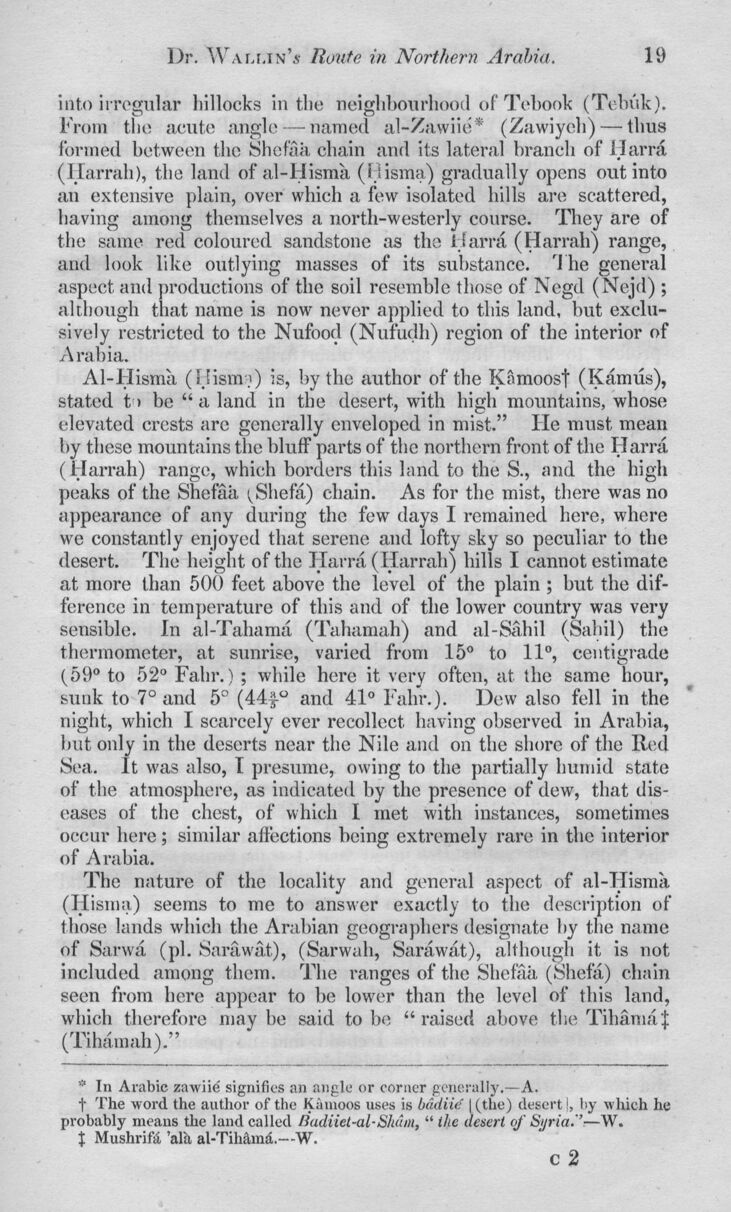
Full resolution (JPEG) - On this page / på denna sida - Route in Northern Arabia

<< prev. page << föreg. sida << >> nästa sida >> next page >>
Below is the raw OCR text
from the above scanned image.
Do you see an error? Proofread the page now!
Här nedan syns maskintolkade texten från faksimilbilden ovan.
Ser du något fel? Korrekturläs sidan nu!
This page has never been proofread. / Denna sida har aldrig korrekturlästs.
[-into-]{+l)r. Wallin’# Route in Northern Arabia.
19
into+} irregular hillocks in the neighbourhood ofTebook (Tebtik).
From tlio acute angle — named al-Zawiie* (Zawiycb) — tlius
formed between the Shcfaa eliain and its lateral branch of Harra
(Harrah), the land of al-Hisma (l iisma) gradually opens out into
an extensive plain, over which a few isolated hills are scattered,
having among themselves a north-westerly course. They are of
the same red coloured sandstone as the Harra (Harrah) range,
and look like outlying masses of its substance. The general
aspect and productions of the soil resemble those of Negd (Nejd);
although that name is now never applied to this land, but
exclusively restricted to the Nufood (Nufudli) region of the interior of
Arabia.
Al-Hisma (11 ism)) is, by the author of the Knmoost (Ivamus),
stated 11 be “ a land in the desert, with high mountains, whose
elevated crests arc generally enveloped in mist.” He must mean
by these mountains the bluff parts of the northern front of the Harra
(Harrah) range, which borders this land to the S., and the high
peaks of the Shefaa (Shefa) chain. As for the mist, there was no
appearance of any during the few days I remained here, where
we constantly enjoyed that serene and lofty sky so peculiar to the
desert. The height of the Harra (Harrah) hills I cannot estimate
at more than 500 feet above the level of the plain; hut the
difference in temperature of this and of the lower country was very
sensible. In al-Tahama (Tahamah) and al-Sahil (Sahil) the
thermometer, at sunrise, varied from 15° to 11°, centigrade
(59° to 52° Falir.) ; while here it very often, at the same hour,
sunk to 7° and 5° (44f° and 41° Falir.). Dew also fell in the
night, which I scarcely ever recollect having observed in Arabia,
hut only in the deserts near the Nile and on the shore of the Red
Sea. It was also, I presume, owing to the partially humid state
of the atmosphere, as indicated by the presence of dew, that
diseases of the chest, of which I met with instances, sometimes
occur here; similar affections being extremely rare in the interior
of Arabia.
The nature of the locality and general aspect of al-JTisma
(Hisina) seems to me to answer exactly to the description of
those lands which the Arabian geographers designate by the name
of Sarwa (pi. Sarawat), (Sarwali, Sarawdt), although it is not
included among them. The ranges of the Shcfaa (Shefa) chain
seen from here appear to be lower than the level of this land,
which therefore may he said to be “ raised above the TihamaJ
(Tihamah).”
* In Arabic zawiid signifies an angle or corner generally.—A.
t The word the author of the Kamoos uses is badii<f | (the) desert |, by which he
probably means the land called Bcujiiet-al-Shum, “ tlic desert of Syria.’’—W.
t Mushrifa ’alii al-Tihtlmd.—W.
c 2
<< prev. page << föreg. sida << >> nästa sida >> next page >>